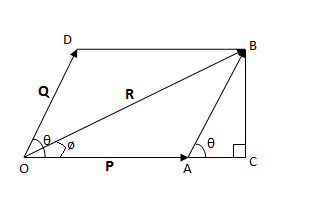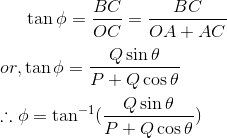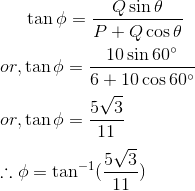Statement of Parallelogram Law
If two vectors acting simultaneously at a point can be represented both in magnitude and direction by the adjacent sides of a parallelogram drawn from a point, then the resultant vector is represented both in magnitude and direction by the diagonal of the parallelogram passing through that point.
Derivation of the law
Note: All the letters in bold represent vectors and normal letters represent magnitude only.
Let P and Q be two vectors acting simultaneously at a point and represented both in magnitude and direction by two adjacent sides OA and OD of a parallelogram OABD as shown in figure.
Let θ be the angle between P and Q and R be the resultant vector. Then, according to parallelogram law of vector addition, diagonal OB represents the resultant of P and Q.

So, we have
R = P + Q
Now, expand A to C and draw BC perpendicular to OC.
From triangle OCB,

In triangle ABC,

Also,

Magnitude of resultant:
Substituting value of AC and BC in (i), we get

which is the magnitude of resultant.
Direction of resultant: Let ø be the angle made by resultant R with P. Then,
From triangle OBC,

which is the direction of resultant.
Numerical Problem
Two forces of magnitude 6N and 10N are inclined at an angle of 60° with each other. Calculate the magnitude of resultant and the angle made by resultant with 6N force.
Solution:
Let P and Q be two forces wih magnitude 6N and 10N respectively and θ be angle between them. Let R be the resultant force.
So, P = 6N, Q = 10N and θ = 60° 
We have,

which is the required magnitude
Let ø be the angle between P and R. Then,

which is the required angle.